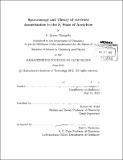| dc.contributor.advisor | Robert W. Field. | en_US |
| dc.contributor.author | Changala, P. Bryan (Peter Bryan) | en_US |
| dc.contributor.other | Massachusetts Institute of Technology. Department of Physics. | en_US |
| dc.date.accessioned | 2013-11-18T19:10:24Z | |
| dc.date.available | 2013-11-18T19:10:24Z | |
| dc.date.copyright | 2013 | en_US |
| dc.date.issued | 2013 | en_US |
| dc.identifier.uri | http://hdl.handle.net/1721.1/82336 | |
| dc.description | Thesis (S.B.)--Massachusetts Institute of Technology, Dept. of Chemistry; and, (S.B.)--Massachusetts Institute of Technology, Dept. of Physics, 2013. | en_US |
| dc.description | Cataloged from PDF version of thesis. | en_US |
| dc.description | Includes bibliographical references (p. 95-99). | en_US |
| dc.description.abstract | This thesis consists of parallel experimental and theoretical studies of the rovibrational structure and dynamics of the Si state of acetylene, C2H2 . This small molecule is a prototypical system for the study of cis-trans isomerization, the barrier to which is moderately low in the Si state, presenting the opportunity to achieve a complete understanding of the global rovibrational dynamics of an isomerizing system. Our analysis of the spectra of ungerade vibrational levels in the region 45800-46550 cm-1 extends the complete assignment of trans vibrational levels to 4300 cm-1 above the Si electronic origin. These exhaustive assignments have enabled the identification of two new cis vibrational states. Reduced dimension rovibrational variational calculations have been carried out to aid in the characterization of spectroscopic signatures and patterns associated with the isomerization process. Such effects include the decoupling of the vibrational polyads that involve the low-energy bending modes [nu]4 and [nu]6 and the large cross-anharmonicity of modes [nu]3 and [nu]6, the combination bands of which follow the isomerization path toward the half-linear transition state. Additionally, we focus on predictions for the K-staggering observed in both cis and trans levels caused by tunneling through the isomerization barrier. The detailed patterns of these staggerings make possible a direct empirical distinction between different possible isomerization mechanisms. We also present an empirical model which analyzes the vibrational level structure along the isomerization path. This model enables the direct spectroscopic characterization of the energy of the transition state, the qualitative structure and width of the isomerization barrier, and the curvature of the nuclear potential surface in directions orthogonal to the isomerization path. This type of analysis is generalizable to other systems, potential surfaces of which contain stationary points and thus provides a powerful new tool for studying transition states via frequency domain spectroscopy. | en_US |
| dc.description.statementofresponsibility | by P. Bryan Changala. | en_US |
| dc.format.extent | 99 p. | en_US |
| dc.language.iso | eng | en_US |
| dc.publisher | Massachusetts Institute of Technology | en_US |
| dc.rights | M.I.T. theses are protected by
copyright. They may be viewed from this source for any purpose, but
reproduction or distribution in any format is prohibited without written
permission. See provided URL for inquiries about permission. | en_US |
| dc.rights.uri | http://dspace.mit.edu/handle/1721.1/7582 | en_US |
| dc.subject | Chemistry. | en_US |
| dc.subject | Physics. | en_US |
| dc.title | Spectroscopy and theory of cis-trans isomerization in the S₁ state of acetylene | en_US |
| dc.type | Thesis | en_US |
| dc.description.degree | S.B. | en_US |
| dc.contributor.department | Massachusetts Institute of Technology. Department of Chemistry | |
| dc.contributor.department | Massachusetts Institute of Technology. Department of Physics | |
| dc.identifier.oclc | 861628634 | en_US |

